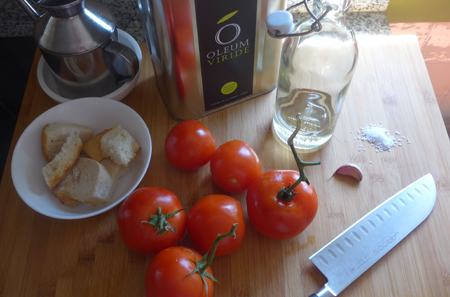
My second recipe! Again, it’s not my idea to turn Endless Mile into a food blog. But after Luis at Oleum Viride saw my description of how to make sopa hervia, he asked if I could publish a recipe for salmorejo. Another Spanish favorite to use leftovers, I just happen to have a fantastic recipe that I often make at home. Enjoy!
Salmorejo
- 1 kg tomatoes, (do a mix if possible: 600g still on vine for flavor + 400g roma variety for color) & at room temp for better emulsion
- 200 g fresh baguette (not dry), torn into small pieces
- 1 clove garlic
- 100 ml olive oil
- 10 g salt
- Items for garnish (see below)
Related to gazpacho but with fewer extra veggies & less bread, salmorejo is known for its creamy, dense texture. There’s no finer way to showcase fresh tomatoes & fine olive oil. Don’t be tempted to add more garlic though… one clove is sufficient (& I am a huge garlic fan). The star of the show should be the tomatoes & olive oil.
Place roughly torn pieces of bread in the bottom of a large bowl with chopped tomatoes on top. Add salt to tomatoes so they release some of their water, draining onto the bread. This step makes emulsification easier, but in a pinch you can skip this step:
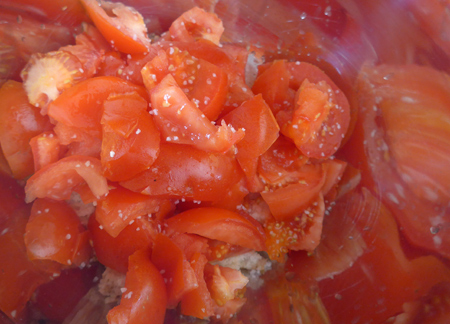
Blend all ingredients except the olive oil with either a handheld or upright blender. The mixture should be a pale red color… whiz to your heart’s content, then slowly add olive oil as if making a mayonnaise. The more you add, the mixture turns a beautiful reddish-orange color:
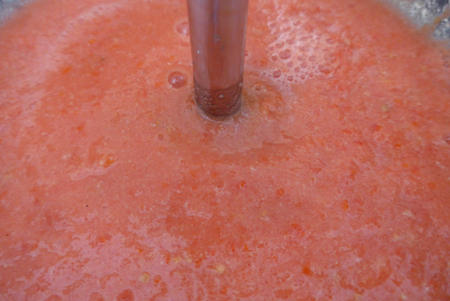
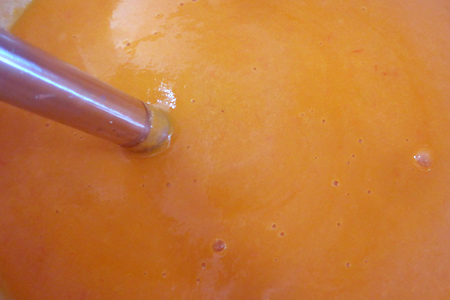
Serve cold but not super chilled… a soup slightly cooler than room temp ensures that the oil’s flavors & aromas come out. Garnish with a little extra olive oil, small cubes of cured ham & chopped pieces of hardboiled egg. Quail eggs are more traditional… if available, hardboil them, peel & slice in half.
Variations on a theme
Of course, everyone’s grandmother has the perfect version of this recipe… anything else amounts to blasphemy 😉 But once you’ve tried a standard version like the one above, then you can move on to find your own favorite. For example, you could try:
- Adding 2 T white vinegar. Purists will naysay, but the acidity helps cut through the denseness of so much olive oil.
- Decrease the amount of bread & add 50 ml extra olive oil (my all-time fave).
- Experiment with different types of olive oil or make your own blend. Oil from arbequina olives is more subtle while the picual variety is more intense.
- Peel tomatoes before chopping.
- Alternative garnishes include chopped apple, orange or shrimp. Again, adding acidity is key.
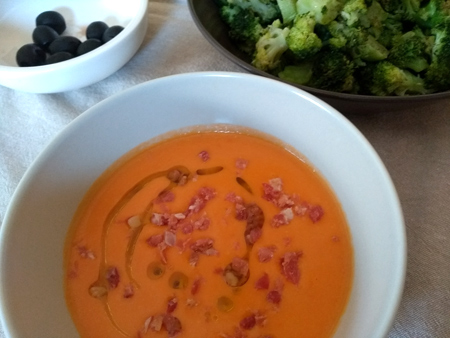
No doubt this cool, summer soup will become a staple for your table. Share your results & tips here!
weird. I went crazy about salmorejo during my trip to Andalusia last january and looked up the recipe when I got back to BA. There were several differences between personal takes, but they all seemed to agree to use day-old bread (and most of them suggested using ripe tomatos). But then again, I guess it’s a matter of taste, right?
PS: The Wikipedia entry for Salmorejo is fascinating, explaining the roman origins of the dish and the slow introduction of tomatos after the conquest of America (apparently, the current recipe is a 20th century invention, which makes sense considering that before the invention of the blender the dish was prepared using a mortar)
https://es.wikipedia.org/wiki/Salmorejo
My husband’s family is from Córdoba, & he spent a lot of time there growing up… he says my salmorejo is the best he’s had 😉 He’s told me how his grandmother would make it with a mortar & pestle as well. Too much work! Yea for blenders!! Of course ripe tomatoes have to be used since they are the protagonist. Also I believe fresh bread adds a richness that dry bread cannot. But to each his own. Can’t believe you’d never had salmorejo before your trip to España. Glad you liked it!
Bonus…a second recipe of one of my favourites. Can’t wait to get home to try this one and the stuffing soup.
This is one of my all-time favorite soups. Enjoy!